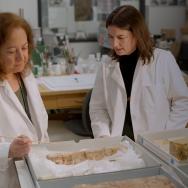Over the past two decades, exhibits like Gods in Color and Chroma have popularized the idea that the ancient world was awash in color. But what do we really know about how ancient peoples understood and used color in their art, architecture, and clothing?
In Color in Ancient Art, an adult education class offered by the Institute for the Study of Ancient Cultures in February, continuing education manager Tasha Vorderstrasse, PhD’04, and senior conservator Alison Whyte shared their knowledge over three evenings on Zoom.
Ancient color
“Did ancient people perceive color the same way we do today?” Vorderstrasse asked during the first class. Her answer—perhaps surprising—was, in some fundamental ways, no. Since dyes and pigments came only from natural sources, the range of available colorants in the ancient world was limited. They also could be costly to produce and apply, so most people had limited access to colorful linens and decorations. Our current theory, in which color is seen as being on a spectrum, is also relatively recent, dating to Isaac Newton’s work with prisms in the mid-17th century.
Vorderstrasse, who specializes in the material culture of Central and West Asia, North Africa, and the South Caucasus, went on to discuss color in ancient languages. Scholars’ understanding of how ancient people in the Near East and North Africa described color, she said, has advanced in recent years, upending a previous belief that ancient cultures had few words for color—especially equivalents for abstract English terms such as “blue” and “green.”
In 2019, Assyriologist Shiyanthi Thavapalan reassessed ancient Mesopotamian language and found that speakers of Akkadian also had many terms for color;.however, they tended to describe them in relation to qualities like brightness and luster rather than hue.
Certain Akkadian color terms derived from precious materials like gold and lapis lazuli, Vorderstrasse added, are challenging to understand. A term like lapis lazuli (uqnûm) might be used to say that an object has the stone’s dark blue hue, or “how shiny it is, or how valuable it is.”
Vorderstrasse’s work on Coptic, a language spoken in Egypt in the first millennium C.E., raises similar questions. Scholars disagree on the meaning of the word djēke or djō(ō)ke, translated variously as “purple” or as “embroidered” or “decorated.” The scarce and valuable Tyrian purple dye was derived from murex snail shells, each of which produced only a few drops of the discharge used for dye. Embroidery was a similarly laborious and costly process. “Is it because purple is so valuable that it starts to mean [embroidered]?” Vorderstrasse asked. Or “Is it that embroidery is expensive and it starts to also mean purple?”
Conserving color
Questions remain about how colors would have appeared hundreds of years ago—even how realistic color application was meant to be—which can prove challenging when conserving ancient objects.
In the final class, senior conservator Alison Whyte showed a number of different analytical techniques at the ISAC’s conservation team’s disposal to determine how color was used. This helps them assess what interventions will be most effective to analyze and protect pigments on items in the museum’s collections.
Conservation only became a formal field of study in the 1950s, explained Whyte. Before that, museums hired artisans to restore the appearance of objects. Today the ISAC conservation team is focused not on aesthetics, but rather on protecting objects from environmental dangers like pests, light, and humidity, and ensuring this cultural heritage can be studied and enjoyed for years to come.
Venus and Cupid
One of Whyte’s case studies was a marble statuette of Venus and Cupid. Originally from Lebanon, the piece dates to the second to third century C.E. ISAC conservators could tell the statuette was decorated with red pigment—for example, on the cloth draped around Venus’s legs and on Cupid’s quiver.
In 2022, examination of the statuette with a digital microscope showed the presence of gold, which in some places appeared to be layered over a dark-red pigment—a common practice, Whyte said, likely used to enhance the gold’s appearance. The gilding appeared to mark an X shape on Venus’s torso, suggesting this work may have been decorated similarly to a statuette of Venus discovered in 1954 in Pompeii and dubbed “Venus in a Bikini” by the Italian press for the extensive body jewelry painted on her nude figure.
Whyte then scanned the statuette with an X-ray fluorescence (XRF) spectrometer, which shoots X-rays at an object and reads the patterns atoms produce in response. Since each element produces a unique pattern, XRF can identify certain elements present on the object’s surface.
Using XRF, conservators were able to confirm the statuette was decorated with gold without having to remove a sample—and that that the dark-red color contained a lot of mercury and sulfur. They theorized this pigment contained cinnabar, made from a mercury sulfide ore, a theory they were later able to confirm by testing a sample of the pigment.
Viewing the statuette under ultraviolet light allowed conservators to confirm that two different red pigments had been used. In addition to the darker cinnabar-based pigment, a lighter, pinkish-red pigment fluoresced orange-red under UV light. Whyte believes this pigment likely contains madder root, a common colorant known to fluoresce in this way.
A painted coffin
A second case study, the coffin of army commander and scribe Ipi-Ha-Ishetef, dates to about 2165–2134 B.C.E. The piece, from Saqqara, Egypt, underwent conservation treatment from 2014 to 2015 with support from an American Research Center in Egypt grant. The goal was to stabilize pigments that were flaking off the wood. To find the right consolidant (material to bind the pigments to the piece), conservators first analyzed the coffin and the pigments.
The interior of the coffin is decorated with items the deceased would need in the afterlife, like food, jewelry, and weapons. On one long side is a door through which the spirit could exit. The mummy would have been placed on its side, facing that door. On one of the short sides, a pair of painted sandals points toward the door, showing where the mummy’s feet would have rested.
The deterioration of the ancient paint, Whyte noted, reveals how paint was layered onto the coffin. On a necklace, for instance, the wear makes clear that painters enlarged the beads, which were initially outlined in red.
Conservators also learned that the coffin exterior had been decorated with Egyptian blue, the oldest known synthetic pigment. Made from calcium, copper, and silica, it was used, most scholars agree, as a cheaper imitation of lapis lazuli.
Project conservator Simona Cristanetti tested many consolidants to find one that would stabilize the pigments without changing the appearance or finish of the piece. In 2015 the coffin was put on display in ISAC’s galleries for the first time in 20 years—where you can view it today.
—A version of this story originally appeared on the UChicago Magazine website.

